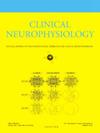新生儿脑病足月新生儿与血糖异常相关的神经生理变化
IF 3.6
3区 医学
Q1 CLINICAL NEUROLOGY
引用次数: 0
摘要
目的探讨治疗性低温治疗新生儿脑病(NE)足月新生儿低血糖/高血糖与脑电图的关系。方法96例新生儿在出生后72 h内进行48 h同步连续血糖监测和脑电图监测。低血糖(≤2.6 mmol/L;≤47 mg/dL)和高血糖(>10.1 mmol/L; >182 mg/dL)分5分钟。连续EEG数据被分割为5 min epoch,与5 min CGM数据相对应。评估视觉脑电背景评分和22项计算脑电测量,并在调整缺氧缺血严重程度和多项测试后评估其与血糖异常的关系。结果96例新生儿中,低血糖12例,高血糖16例,其中1例低血糖和高血糖同时发生。在校正分析中,高血糖时期与较差的视觉背景评分(1.2,95% CI 0.51-1.89, q = 0.003)和11项计算脑电图测量相关。相比之下,低血糖期与视觉背景评分的显著变化无关(- 0.28,95% CI - 0.66 - - 0.10, q = 0.549),并且仅与一项计算脑电图测量相关。结论甲状腺素治疗足月新生儿低血糖与脑功能改变具有暂时性相关性。这种时间关系提示高血糖水平可能直接导致NE后脑损伤。本文章由计算机程序翻译,如有差异,请以英文原文为准。
Neurophysiological changes associated with dysglycemia in term neonates with neonatal encephalopathy
Objective
To investigate the relationship between hypo/hyperglycemia and EEG measures in term neonates with neonatal encephalopathy (NE) treated with therapeutic hypothermia (TH).
Methods
Ninety-six neonates underwent concurrent continuous glucose monitoring (CGM) and EEG for 48 h within the first 72 h of life. Five-minute epochs of hypoglycemia (≤2.6 mmol/L; ≤47 mg/dL) and hyperglycemia (>10.1 mmol/L; >182 mg/dL) were identified. Continuous EEG data was segmented into 5-min epochs corresponding to 5-min CGM data. Visual EEG background score and 22 computational EEG measures were estimated and their relationship to dysglycemia was assessed after adjusting for hypoxia–ischemia severity and multiple testing.
Results
Among the 96 neonates, 12 had hypoglycemia, 16 had hyperglycemia, including 1 with both during the recording period. In the adjusted analyses, hyperglycemic epochs were associated with worse visual background scores (1.2, 95 %CI 0.51–1.89, q = 0.003) and 11 computational EEG measures. In contrast, hypoglycemic epochs were not associated with a significant change in visual background scores (−0.28, 95 %CI −0.66 − −0.10, q = 0.549), and were only associated with one computational EEG measure.
Conclusions
Hyperglycemia is temporally associated with changes in brain function in term neonates with NE treated with TH.
Significance
This temporal relationship suggests high glucose levels may contribute directly to brain injury after NE.
求助全文
通过发布文献求助,成功后即可免费获取论文全文。
去求助
来源期刊

Clinical Neurophysiology
医学-临床神经学
CiteScore
8.70
自引率
6.40%
发文量
932
审稿时长
59 days
期刊介绍:
As of January 1999, The journal Electroencephalography and Clinical Neurophysiology, and its two sections Electromyography and Motor Control and Evoked Potentials have amalgamated to become this journal - Clinical Neurophysiology.
Clinical Neurophysiology is the official journal of the International Federation of Clinical Neurophysiology, the Brazilian Society of Clinical Neurophysiology, the Czech Society of Clinical Neurophysiology, the Italian Clinical Neurophysiology Society and the International Society of Intraoperative Neurophysiology.The journal is dedicated to fostering research and disseminating information on all aspects of both normal and abnormal functioning of the nervous system. The key aim of the publication is to disseminate scholarly reports on the pathophysiology underlying diseases of the central and peripheral nervous system of human patients. Clinical trials that use neurophysiological measures to document change are encouraged, as are manuscripts reporting data on integrated neuroimaging of central nervous function including, but not limited to, functional MRI, MEG, EEG, PET and other neuroimaging modalities.
 求助内容:
求助内容: 应助结果提醒方式:
应助结果提醒方式:


